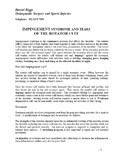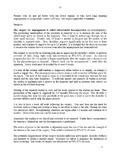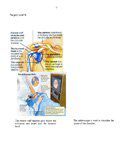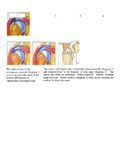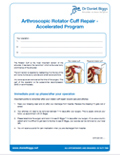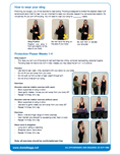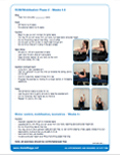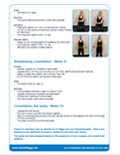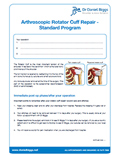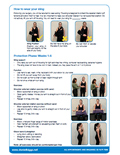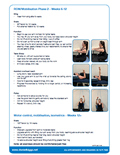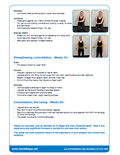Rotator Cuff Tear
What is the Rotator Cuff?
The rotator cuff is made up of four muscles that help move and stabilize the shoulder joint.
The four rotator cuff muscles include the:
- Supraspinatus
- Infraspinatus
- Subscapularis
- Teres minor
What is a Rotator Cuff Tear?
Rotator Cuff Tear is the medical term for when the tendon no longer fully attaches to the head of the humerus. Most tears occur in the supraspinatus muscle and tendon, however other areas of the rotator cuff may also be involved.
The torn tendon often begins by becoming frayed, and as the damage progresses the tendon can completely tear.
There are two types of tears:
- Partial tear; damage of the soft tissue but does not completely sever it
- Full-Thickness Tears; when the tissue is split into two pieces.
Causes of Rotator Cuff Tear:
- Injury
- Degeneration
- Repetitive stress
- Lack of blood supply
- Bone spurs
Rotator Cuff Tear symptoms
Rotator Cuff Tear usually causes pain and sufferers have the following symptoms:
- Weakness of the arm
- Crackling sensation when moving the shoulder(crepitus)
- Difficulty with above shoulder height level lifting
- Night pain
Diagnosis of Rotator Cuff Tear
Dr Biggs will need to diagnose a Rotator Cuff Tear
Diagnostic methods include:
Consultation - During this consultation Dr Biggs will:
- Take a medical history
- Perform a physical examination
- Assess the shoulder’s range of motion
Imaging tests - In order to clearly understand the nature of any loss of the joint space or bone spur formation imaging scans are required:
- X-rays- the first imaging tests performed are usually x-rays. Because x-rays do not show the soft tissues of your shoulder like the rotator cuff, plain x-rays of a shoulder with rotator cuff pain are usually normal or may show a small bone spur
- MRI - can create detailed images of both hard and soft tissues, and will produce a much clearer image of the rotator cuff. An MRI can produce cross-sectional images of internal structures required if the diagnosis is unclear.
- Ultrasound - can allow the doctor to examine the inside of your affected area in motion.
While not all of these approaches or tests are required to confirm the diagnosis, this diagnostic process will also allow Dr Biggs to review any possible risks or existing conditions that could interfere with the surgery or its outcome.
Treatment for Rotator Cuff Tear
Non-Surgical Treatment can include:
- Rest from pain provoking activities
- Physiotherapy
- Steroid injection
Arthroscopic Rotator Cuff Tear Surgery
If the non-surgical treatments do not resolve the patient’s symptoms, the patient may then require surgery for Rotator Cuff Tear.
- Two or three small incisions (portals) are made. In one portal, the arthroscope is inserted to view the shoulder joint.
- A sterile solution is pumped to the joint which expands the shoulder joint, giving the surgeon a clear view and room to work.
- With the images from the arthroscope as a guide, the surgeon can look for any pathology or anomaly. The large image on the television screen allows the surgeon to see the joint directly and to determine the extent of the injuries, and then perform the particular surgical procedure, if necessary.
In some cases
- the front (anterior) edge of the acromion is removed along with some of the bursal tissue and last four or five millimetres of the clavicle to increase subacromial space for the rotator cuff tendons.
- Holes are drilled into the humerus to accommodate the suture anchors.
The cuff tear is repaired
- Using suture anchors that are inserted into the humerus bone
- Strong sutures from the anchors are placed in the torn ends of the rotator cuff tendons
After the surgery, the incisions (portals) are closed by sutures and the patient is taken to the recovery room.
Untreated Rotator Cuff Tear
A Rotator Cuff Tear is not life threatening but can severely impact a patient’s quality of life and function.
It can affect anyone: elite athletes and the active individual, manual labourers and office workers.
Rotator Cuff Surgery Risks
As with any major surgery there are potential risks involved. The decision to proceed with the surgery is made because the advantages of surgery outweigh the potential disadvantages.
It is important that the patient is informed of these risks before the surgery takes place.
Complications can be medical (general) or specific to surgery.
Medical complications include those of the anaesthetic and your general well being. Almost any medical condition can occur so this list is not complete. Complications include:
- Allergic reactions to medications
- Blood loss requiring transfusion with its low risk of disease transmission
- Heart attacks, strokes, kidney failure, pneumonia, bladder infections.
- Complications from nerve blocks such as infection or nerve damage.
Serious medical problems can lead to ongoing health concerns, prolonged hospitalisation or rarely death.
Specific complications for surgery are rare but may include:
Infection- Infections can occur superficially at the incision or in the joint space of the shoulder, a more serious infection. Infection rates vary; if it occurs it can be treated with antibiotics but may require further surgery.
Shoulder Stiffness- Shoulder stiffness with loss of range of motion is a common complication that can be greatly minimized with strict adherence to your occupational therapy program prescribed by your surgeon.
Damage to nerves of Blood Vessels- Also rare but can lead to weakness or loss of sensation in part of the arm. Damage to blood vessels may require further surgery if bleeding is ongoing.
Damage to the joint- Joint damage to the cartilage or other structures can occur during surgery and may require another operation to repair.
Blood Clots (Deep Venous Thrombosis)- Blood Clots can form in the arm muscles and can travel to the lung (Pulmonary embolism). These can occasionally be serious and even life threatening. If the patient suffers arm pain, redness or swelling, or have shortness of breath at any stage, contact Dr Biggs
Preparation for Rotator Cuff Surgery
Once Dr Biggs decides that surgery is required, preparation is necessary to achieve the best results and a quick, problem free recovery.
Preparing mentally and physically for surgery is an important step toward a successful result.
- Dr Biggs will create a treatment plan and
- Patients will also need to understand the process and their role in it
Participating and completing a tailored exercise program before (ie. pre-hab) with a trained physiotherapist will achieve the best result after surgery.
Dr Biggs will also need to:
- Discuss any medications being taken with your doctor or physician to see which ones should be stopped before surgery
- Do not eat or drink anything, including water, for 6 hours before surgery
- Stop taking aspirin, warfarin, anti-inflammatory medications or drugs that increase the risk of bleeding one week before surgery to minimise bleeding
- Review blood replacement options (including banking blood) with your doctor
- Stop or cut down smoking to reduce your surgery risks and improve your recovery
Report any infections to Dr Biggs prior to surgery as the procedure cannot be performed until all infections have cleared up.
Post Surgery
The patient will wake up in the recovery room and then be transferred back to their hospital room.
- Pain medication will be provided to keep the patient comfortable.
- A bandage will be around the operated shoulder and the arm will be in a sling or brace.
- The sling will be worn for about 4-6 weeks to facilitate healing.
Dr Biggs will see the patient prior to discharge and explain the findings of the operation and what was done during Surgery.
- The bandage will usually be removed 48 hours post surgery and place dressings provided by your surgeon over the area.
- It is normal for the shoulder to swell after the surgery.Placing Ice-Packs on the shoulder will help to reduce swelling. Ice packs should be applied to the area for 20 min 3-4 times a day until swelling has reduced.
The patient should keep a pillow under their elbow while lying in bed.
- The patient will not be allowed to lift anything over your head or anything greater than 1 kilo for the first 6 weeks.
- 7-10 days after surgery Dr Biggs will see the patient to monitor their progress and remove the sutures.
It is recommended that the patient not drive during the first 6 weeks while wearing a sling due to safety reasons and the risk of injury to the surgical site.
The patient will be given specific instructions regarding activity and a rehabilitation program of exercise and strengthening.
Eating a healthy diet and not smoking will promote healing.
Patient Information Handout
Impingement Syndrome & Tears of the Rotator Cuff
![]() Click here to download the PDF
Click here to download the PDF
Post-operative protocol following rotator cuff repair
Arthroscopic Rotator Cuff Repair - Accelerated Program
![]() Click here to download the PDF
Click here to download the PDF
Arthroscopic Rotator Cuff Repair - Standard Program

